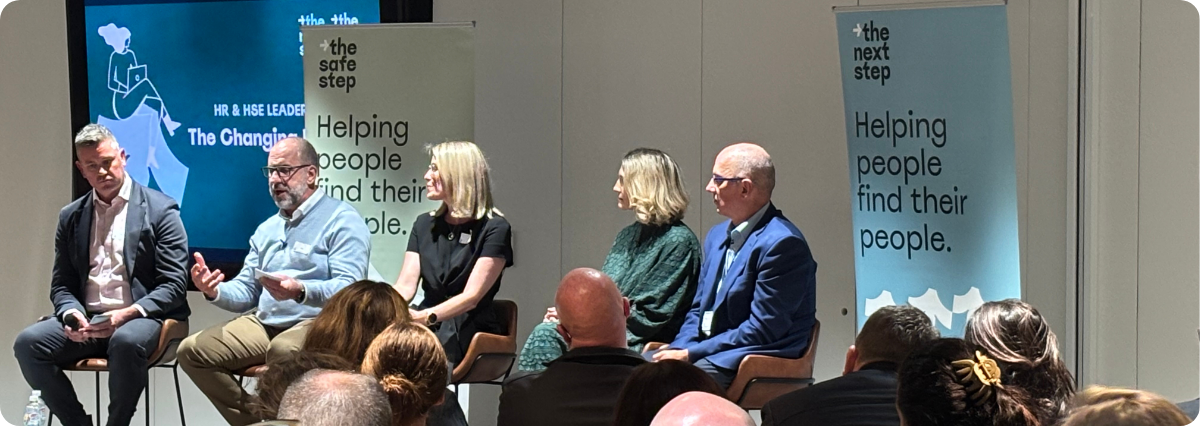Why Safety Leaders Are Getting Board Attention in 2025
Page Published Date:
June 3, 2025
Your safety metrics show a department with above-average near-miss reports but no actual injuries. HR data reveals the same department has the highest stress leave applications and workplace complaint escalations. Separately, each metric suggests different issues. Together, they reveal a team under pressure whose heightened vigilance is preventing incidents—but at an unsustainable cost to employee wellbeing.

Many leaders we speak to are highlighting the increased blurring of lines between HR and safety, a theme echoed at The Safe Step's recent HR & HSE Leadership Forum where seasoned safety professionals shared a common realisation: the days of operating in functional silos are over. The message from forum panellists was clear: safety professionals who master cross-functional collaboration aren't just staying relevant—they're becoming indispensable.
The Convergence That's Rewriting Safety Leadership
Robert Tanti, Chief People Officer at Opal, captured the fundamental shift facing safety professionals: "When we look at psychosocial hazard identification, risk management, prevention and even reaction, you put safety and HR together and you actually perfect the formula. You've got all the information needed to position your organisation upstream rather than reactive."
This isn't about safety professionals becoming HR generalists. It's about recognising that the most significant workplace risks now sit at the intersection of both domains. Anna Feringa, Workplace Mental Health Consultant, made this concrete: " Poor interpersonal relationships, conflicts, and poorly executed performance management practices account for a large portion of Workers compensation claims, closely followed by workload. You're actually in control of more of those risks than traumatic events."
The implication is clear. Performance management conflicts, workload pressures, interpersonal tensions—these aren't just HR issues. Under psychosocial legislation, they're safety hazards requiring the same systematic approach you'd apply to any workplace risk.
Breaking Down the Data Walls
Safety professionals have always been data-driven, and now there's an opportunity to expand that expertise to include people data that reveals broader organisational risk patterns. The problem is accessing information that's locked in HR systems.
Rod Maule, Safety Executive and Strategic Advisor for The Safe Step, highlighted the practical challenge: "We've all got reporting systems for safety. Then HR receives a bullying complaint. Where does it go and who sees it?"
The privacy challenge is real but manageable. As Feringa noted, information can "still be moderated and protected" while enabling the collaboration both functions need to keep people safe.
How Safety Leaders Are Getting Board Attention
Boards are demanding integrated risk reporting that no single function can provide alone. They want comprehensive insights about organisational health, not fragmented updates from competing departments.
This creates an opportunity for safety professionals who can speak to broader people risks. Boards want leaders who can synthesise information and present coherent risk assessments, not siloed safety reports alongside separate HR updates.
Caitlin Ible, Partner at MinterEllison, explained the regulatory driver: "We're seeing a real convergence of what was traditionally health and safety, with respect at work, with the Fair Work Act—all these different pieces of compliance and regulation."
For safety professionals, this convergence represents a rare opportunity to influence strategic decisions. Boards that once viewed safety as an operational concern now recognise it as integral to organisational resilience. But capturing this opportunity requires speaking the language of integrated risk management, not just traditional safety compliance.
The safety leaders gaining the most traction are those who can connect their insights to broader business outcomes—linking safety performance to retention, productivity, and reputation management.
The Technology Factor Expanding Your Influence
AI and workplace technology are creating new collaboration imperatives. Ible highlighted emerging challenges: "With wearable technologies and privacy concerns around employee surveillance, how we integrate technology safely requires both safety and people expertise."
Maule's experience at Australia Post illustrates both the potential and the complexity: implementing safety technology delivered a 98% reduction in people-plant exposure incidents, but success required "working very closely with HR, operations, and IT to make sure we had the right balance."
The lesson for safety professionals is clear: technical safety knowledge alone isn't sufficient for technology implementation. Success increasingly depends on understanding change management, stakeholder engagement, and the people impacts of technological solutions—skills traditionally associated with HR and organisational development.
Beyond HR: The Expanding Network of Collaboration
Smart safety professionals are recognising that HR integration is just the beginning. Tanti emphasised the multi-stakeholder reality: "When you start to design psychosocial safety systems, it's not actually just HR. It's the finance guys, it's the engineers, it's the production managers, it's supply chain, it's the shop floor operators."
This expansion creates opportunities for safety professionals who can operate across business functions. ESG reporting increasingly requires safety professionals who understand sustainability metrics and stakeholder engagement. Operations teams need safety leaders who grasp lean principles and process improvement.
Aaron Neilson, experienced HSE Executive recruiter and The Safe Step CEO, observes the market evolution: "We're seeing newly created roles that blur traditional boundaries. The most successful safety leaders are those who can think holistically about employee experience—considering all factors that influence both performance and wellbeing."
The Skills That Separate Strategic Safety Leaders
Forum discussions identified four capabilities that distinguish strategic safety leaders from their compliance-focused peers:
- Cross-functional fluency: Understanding HR processes well enough to identify safety-relevant insights, and translating safety requirements into business language that drives executive action.
- Systems thinking: Moving beyond incident analysis to understand how people data, operational data, and safety data intersect to reveal organisational risk patterns.
- Strategic communication: Presenting safety insights in business terms that resonate with boards and executives, positioning safety as a business enabler rather than a cost centre.
- Change leadership: Managing technology implementation and cultural shifts that affect safety outcomes while navigating competing stakeholder interests across multiple functions.
Neilson's advice for developing these capabilities: "Take on projects that expose you to psychosocial risk management, collaborate with HR colleagues, and look for learning opportunities outside traditional safety pathways."
Making the Transition: Where to Start
The forum's most practical advice came from Tanti's approach to proving value: "Pick a site everyone knows is struggling. Implement integrated approaches and track both traditional safety metrics and cross-functional indicators. This creates compelling proof points for broader rollout."
This strategy works because it demonstrates tangible outcomes rather than theoretical benefits. When safety professionals can show how collaboration improved both safety performance and business metrics, they build credibility for broader integration.
Other immediate steps include volunteering for cross-functional projects, developing basic business literacy, and creating informal information-sharing protocols with HR colleagues. The goal isn't to become an HR expert, but rather to build enough understanding to collaborate effectively.
What Success Looks Like
The most successful safety leaders aren't abandoning their technical expertise—they're amplifying it through strategic partnerships. Feringa captured this evolution: "With the fusion of safety and human resources, you actually stand a better chance of being safer. With two particular divisions collaborating, you have a better opportunity to create better capability with frontline people and middle managers."
This represents a shift from compliance-focused to strategically influential safety leadership. The career advantages belong to those who recognise this shift and develop the integrated capabilities the new landscape demands.
The safety profession is evolving, and the leaders who master cross-functional collaboration will define its next chapter. The question isn't whether this integration will continue—it's how quickly you can develop the skills to lead it.




